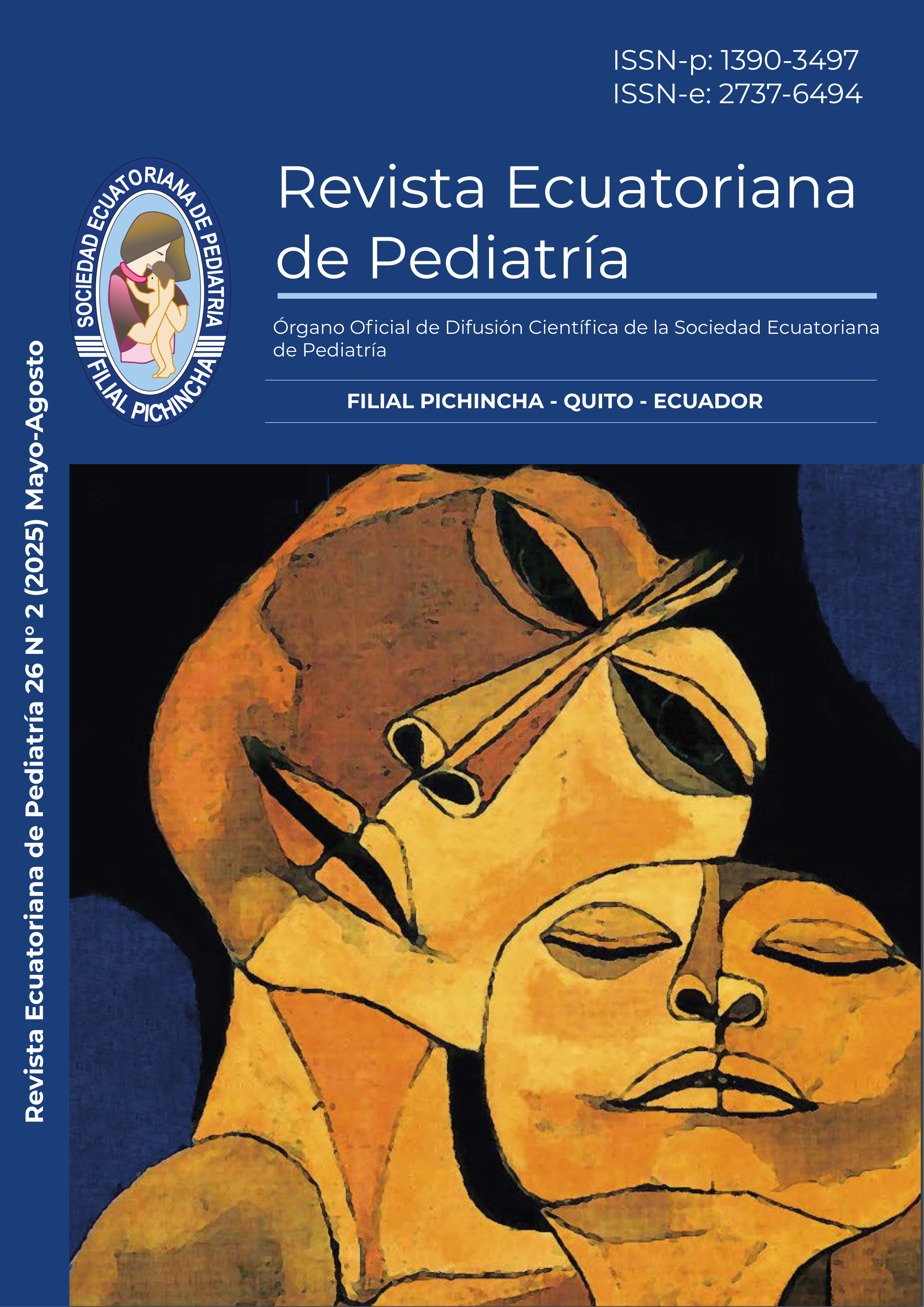Perinatal Asphyxia and Hypoxic-Ischemic Encephalopathy. A Systematic Review
Main Article Content
Abstract
Hypoxic-ischemic encephalopathy (HIE) is the leading cause of acquired brain injury and disability in full-term neonates. It is estimated that while the incidence is 1 to 6 per 1,000 live births in developed countries, it can rise to 25 per 1,000 in developing countries, underscoring a significant global disparity. Perinatal asphyxia, defined as a severe impairment in gas exchange during the peripartum, intrapartum, or the first minutes after birth, can cause multi-system damage. This systematic review was conducted following the PRISMA 2020 statement guidelines to ensure transparency and quality. An exhaustive search was carried out in the biomedical databases Scopus and Web of Science. The study selection process involved a two-stage review to identify potentially relevant studies, and ultimately, 19 studies were included in the review. Perinatal asphyxia and HIE have been redefined as a complex syndrome with a multifactorial etiology. The reviewed evidence confirms that therapeutic hypothermia is an effective neuroprotective intervention in high-income countries, but its success is not universal and depends on the available support infrastructure, which explains the discrepancy in results in limited-resource settings. HIE is a multi-systemic syndrome, and the dysfunction of other organs is directly correlated with the neurological prognosis. Finally, multidisciplinary follow-up is essential to address the wide spectrum of long-term sequelae, such as cerebral palsy, epilepsy, and cognitive and learning deficits, which often manifest over time.
Downloads
Article Details

This work is licensed under a Creative Commons Attribution-NonCommercial-ShareAlike 4.0 International License.
References
García-Alix A, Arnaez J, Arca G, Martinez-Biarge M. Código encefalopatía hipóxico-isquémica: revisión sistematizada para entornos con recursos limitados. An Pediatría [Internet]. 2024 Apr;100(4):275–86. Available from: https://linkinghub.elsevier.com/retrieve/pii/S1695403324000560
Iribarren I, Hilario E, Álvarez A, Alonso-Alconada D. Fallo multiorgánico neonatal tras asfixia perinatal. An Pediatría [Internet]. 2022 Oct;97(4):280.e1-280.e8. Available from: https://linkinghub.elsevier.com/retrieve/pii/S1695403322001965
García-Alix Pérez A. Estado fetal no tranquilizador, asfixia perinatal y encefalopatía neonatal. An Pediatría (English Ed [Internet]. 2020;63(1):1–4. Available from: https://analesdepediatria.org/es-estado-fetal-no-tranquilizador-asfixia-articulo-13076760
García-Alix A, Jiménez JQ. Asfixia intraparto y encefalopatía hipóxico-isquémica. Junta Dir la Asoc Española Pediatría. 2022;(43).
Guzmán V, Pico P. ASFIXIA PERINATAL Y ENCEFALOPATÍA HIPÓXICO-ISQUÉMICA. Sociedad Ecuatoriana de Pediatría; 2025.
Manzini E, Borellini M, Belardi P, Mlawa E, Kadinde E, Mwibuka C, et al. Factors associated with mortality and neurodevelopmental impairment at 12 months in asphyxiated newborns: a retrospective cohort study in rural Tanzania from January 2019 to June 2022. BMC Pregnancy Childbirth [Internet]. 2024 Oct 10;24(1):660. Available from: https://bmcpregnancychildbirth.biomedcentral.com/articles/10.1186/s12884-024-06837-w
HIE. Causas y Riesgos de la EHI [Internet]. 2025. Available from: https://hiehelpcenter.org/espanol/causas-riesgos-ehi/
PAPAZIAN O. ENCEFALOPATÍA HIPÓXICA-ISQUÉMICA NEONATAL. Med (Buenos Aires. 2018;78(2):36–41.
Pinzón Flórez V. Pronóstico neurológico según la variabilidad de la frecuencia cardiaca en neonatos con encefalopatía Hipóxico-Isquémica sometidos a protocolo de hipotermia. Revisión de alcance [Internet]. Universidad del Rosario; 2021. Available from: https://repository.urosario.edu.co/server/api/core/bitstreams/8c4ffbcf-56cc-4c02-b35a-d30545c8b879/content
Narváez-Aguilar LF, Quiroz-Vega LL. Uso de la escala Sarnat para la clasificación de la encefalopatía hipóxico isquémica. ACTA MEDICA Peru [Internet]. 2023 Aug 1;40(2). Available from: https://amp.cmp.org.pe/index.php/AMP/article/view/2601
Guía de Rerencia Rápida: Guía de Práctica Clínica. Diagnóstico, Tratamiento y Pronóstico de la ENCEFALOPATÍA HIPÓXICO-ISQUÉMICA [Internet]. Durango: Instituto Mexicano del Seguro Social; 2017. Available from: https://www.imss.gob.mx/sites/all/statics/guiasclinicas/371GRR.pdf
Fasce J, Novoa JM, Toso P, García-Alix A. Estado actual de la Hipotermia Terapéutica en la Encefalopatía Hipóxico-Isquémica. Andes Pediatr [Internet]. 2021 Dec 28;92(6):831. Available from: https://www.revistachilenadepediatria.cl/index.php/rchped/article/view/4024
García DA, Romero H, Colmenares AE. ASFIXIA PERINATAL. Repert.med.cir. 2023;22(1):28–37.
Martínez-Biarge M, Blanco D, García-Alix A, Salas S. Seguimiento de los recién nacidos con encefalopatía hipóxico-isquémica. An Pediatría [Internet]. 2014 Jul;81(1):52.e1-52.e14. Available from: https://linkinghub.elsevier.com/retrieve/pii/S1695403313003330
Marquez J. Parálisis Cerebral 2025, todo lo que debes saber. Análisis del artículo de I. Novak de The Lancet. 2025.
Ibáñez S, Lara Herguedas J. Crisis neonatales. Protoc diagn ter pediatr. 2022;(1):387–97.
Cruz-Cruz M del R, Gallardo-Elías J, Paredes-Solís S, Legorreta-Soberanis J, Flores-Moreno M, Andersson N. Factores asociados a epilepsia en niños en México: un estudio caso-control. Bol Med Hosp Infant Mex [Internet]. 2017 Sep;74(5):334–40. Available from: http://linkinghub.elsevier.com/retrieve/pii/S1665114616301794
Garcia-Alix A, Arnaez J, Herranz-Rubia N, Alarcón A, Arca G, Valverde E, et al. Una década después de la implantación en España de la hipotermia terapéutica en el recién nacido con encefalopatía hipóxico-isquémica perinatal. Neurología [Internet]. 2023 Jun;38(5):364–71. Available from: https://linkinghub.elsevier.com/retrieve/pii/S0213485320302279
Prakash R, Verónica Reyes-García D, Somanath Hansoge S, Rosenkrantz TS. Therapeutic hypothermia for neonates with hypoxic-ischaemic encephalopathy in low- and lower-middle-income countries: a systematic review and meta-analysis. J Trop Pediatr [Internet]. 2024

